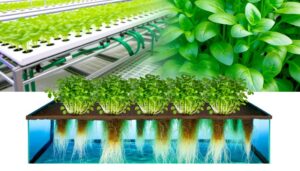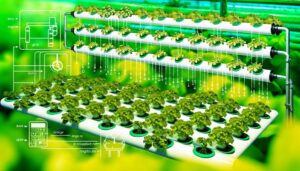How to Use a Hydroponic System
To use a hydroponic system, begin with selecting an appropriate type such as Nutrient Film Technique (NFT), Deep Water Culture (DWC), or Aeroponics, based on your plant species and spatial constraints. Set up involves positioning the system in a location with ideal light and temperature conditions (65-75°F).
Equip with grow lights, air pumps, pH meters, and water pumps for essential functions. Prepare the nutrient solution, maintaining a pH of 5.5-6.5, and monitor Electrical Conductivity (EC) for precise nutrient concentrations.
Regularly evaluate plant health, adjusting pH and nutrient levels as needed. Further steps will enhance your understanding of advanced hydroponic methodologies.
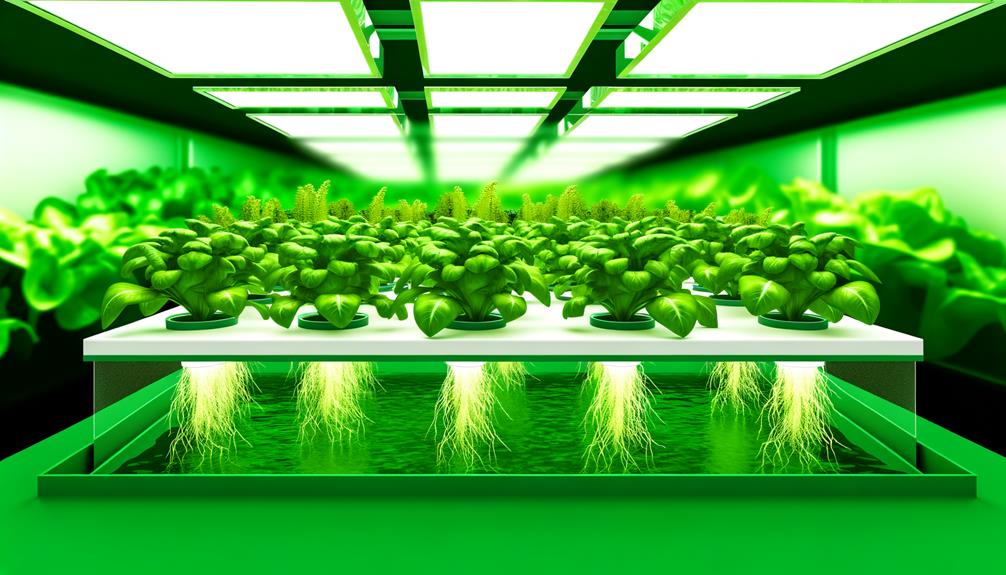
Key Takeaways
- Choose a hydroponic system suited to your plant type, space, and budget.
- Set up in a location with stable temperatures, good ventilation, and adequate light.
- Use high-quality nutrient solutions and maintain a pH of 5.5 to 6.5.
- Regularly monitor pH levels, nutrient concentrations, and plant health.
Understanding Hydroponics
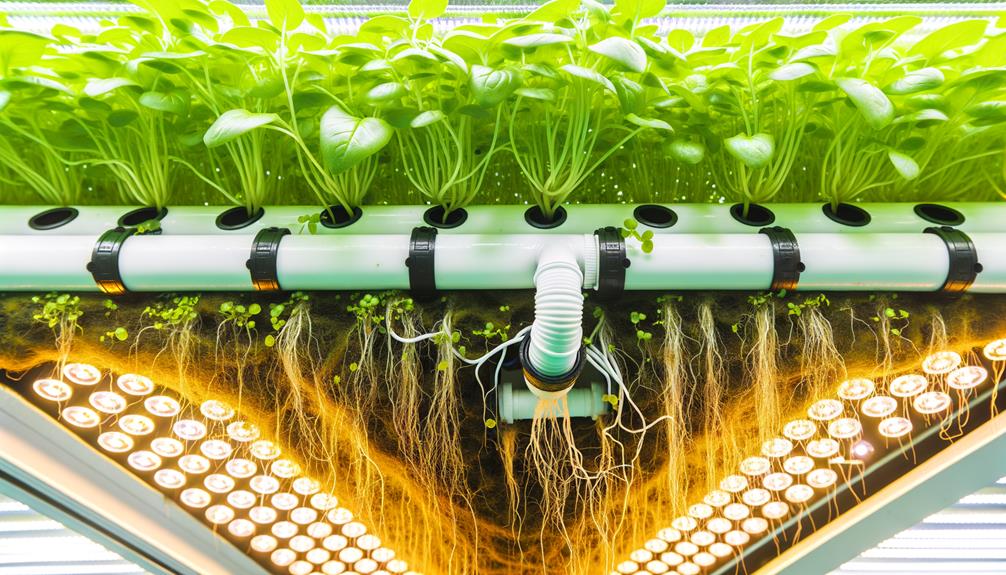
Hydroponics, derived from the Greek words for water ('hydro') and labor ('ponos'), refers to the method of cultivating plants without soil, utilizing mineral nutrient solutions in an aqueous solvent.
This technique relies on precise control of environmental conditions including pH levels, temperature, and nutrient concentration, ensuring ideal plant growth and yield.
The hydroponic system can be categorized into various types such as nutrient film technique (NFT), deep water culture (DWC), and aeroponics, each with distinct mechanisms to deliver nutrients directly to plant roots.
By eliminating soil, hydroponics minimizes the risk of soil-borne diseases and pests, fostering a more controlled and efficient agricultural environment.
This method revolutionizes traditional farming, providing avenues for sustainable and innovative agricultural practices.
Benefits of Hydroponic Systems
One of the primary advantages of hydroponic systems is their ability to greatly enhance plant growth rates and yields through optimized nutrient delivery and environmental control. By eliminating soil, hydroponics allows for precise management of nutrient solutions, leading to superior plant health and faster growth cycles. Controlled environments also minimize pathogen risks and reduce the need for chemical pesticides. Additionally, hydroponic systems are known for their efficient use of water and space, making them ideal for urban agriculture.
| Advantage | Description | Benefit |
|---|---|---|
| Optimized Nutrient Delivery | Precise nutrient management | Enhanced growth rates |
| Controlled Environment | Minimized pathogen risks | Less pesticide use |
| Water Efficiency | Significant water savings | Sustainable resource use |
| Space Efficiency | Vertical farming potential | Increased crop density |
| Faster Growth Cycles | Accelerated plant development | Higher yields |
Types of Hydroponic Systems
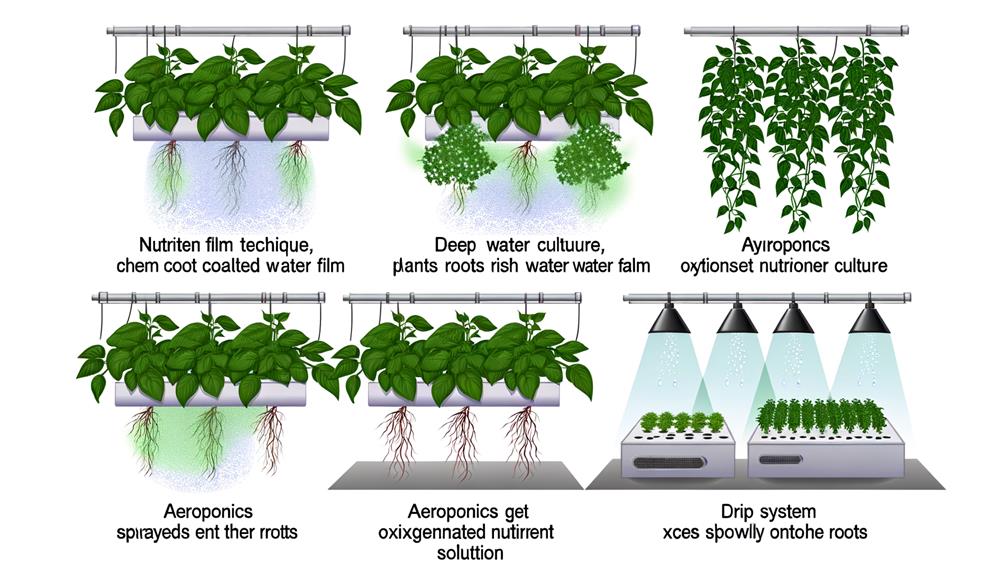
Understanding the various types of hydroponic systems is paramount to selecting the most appropriate setup for specific plant needs and cultivation goals.
These systems are broadly categorized into six main types: Nutrient Film Technique (NFT), Deep Water Culture (DWC), Wick System, Ebb and Flow (Flood and Drain), Drip System, and Aeroponics.
NFT utilizes a thin film of nutrient solution, optimizing oxygenation.
DWC suspends plant roots in an oxygenated nutrient solution, promoting rapid growth.
The Wick System employs capillary action for nutrient delivery, ideal for smaller plants.
Ebb and Flow systems flood the root zone temporarily, ensuring nutrient uptake.
Drip Systems provide controlled nutrient delivery via emitters.
Aeroponics suspends roots in air, misting them with nutrients, maximizing oxygen exposure.
Choosing Your System
Selecting the most suitable hydroponic system involves evaluating factors such as plant type, available space, budget, and desired maintenance level.
Different systems, including Nutrient Film Technique (NFT), Deep Water Culture (DWC), and Aeroponics, cater to specific requirements. For instance, NFT is ideal for leafy greens due to continuous nutrient flow, while DWC supports larger plants with its oxygen-rich water.
Spatial constraints and scalability should guide the choice between vertical and horizontal setups. Budget considerations encompass initial investment and operational costs, impacting system complexity and automation.
Maintenance levels, dictated by system type, range from periodic nutrient solution checks in DWC to more frequent monitoring in Aeroponics. A thorough analysis guarantees the best system selection aligned with cultivation goals.
Setting Up Your System
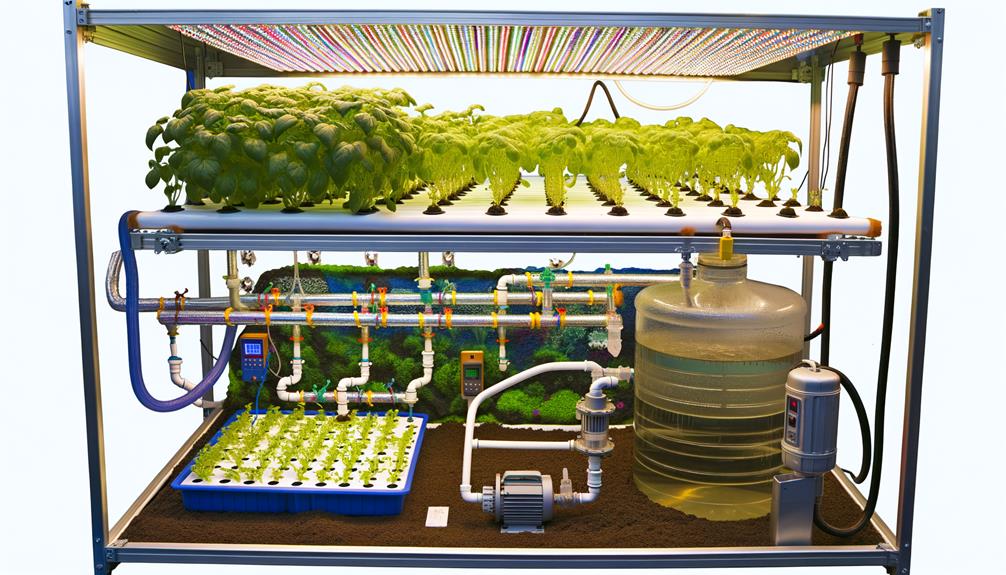
To establish an effective hydroponic system, it is important to select an ideal location that guarantees adequate light and stable environmental conditions.
Essential equipment, including grow lights, pumps, and reservoirs, must be meticulously chosen to align with system specifications.
Additionally, precise preparation of the nutrient solution is critical to deliver the necessary minerals and compounds for plant growth.
Choosing Ideal Location
Determining the ideal location for your hydroponic system is vital for guaranteeing adequate light exposure, temperature control, and access to essential resources.
Optimal positioning should be in an environment where photoperiod and light intensity can be precisely regulated, typically via artificial grow lights.
Temperature stability, ideally between 65-75°F (18-24°C), is critical to prevent thermal stress on plants.
Additionally, make sure the site has robust ventilation to mitigate humidity levels and promote gas exchange.
Ease of access to water and nutrients will streamline system maintenance and nutrient solution management.
Essential Equipment Needed
A successful hydroponic system requires a thorough array of specialized equipment, each serving a significant function in the cultivation process. Key components include grow lights, essential for photosynthesis; air pumps, important for oxygenating the nutrient solution; and pH meters, critical for maintaining ideal pH levels. Additionally, water pumps guarantee efficient nutrient delivery, while grow trays support plant structure and root development. The following table outlines these indispensable items: Proper ventilation systems help regulate temperature and humidity, creating an optimal growing environment for plants. Additionally, timers automate lighting and watering schedules, ensuring consistency in the step by step hydroponic system. By integrating these components efficiently, growers can maximize plant health and yield while minimizing potential complications.
| Equipment | Function | Importance |
|---|---|---|
| Grow Lights | Mimics natural sunlight | Essential for photosynthesis |
| Air Pumps | Oxygenates nutrient solution | Guarantees root respiration |
| pH Meters | Monitors pH levels | Maintains ideal growth conditions |
| Water Pumps | Circulates nutrients | Promotes even nutrient distribution |
| Grow Trays | Supports plants | Facilitates root development |
Properly configuring each element will enhance system efficiency and yield ideal results.
Nutrient Solution Preparation
Proper nutrient solution preparation is a critical step in setting up your hydroponic system, ensuring that plants receive a well-balanced mix of essential minerals and nutrients for optimal growth.
Begin by selecting a high-quality hydroponic nutrient mix, tailored to your plant species.
Dissolve the mix in dechlorinated water, maintaining an ideal pH range of 5.5 to 6.5, to facilitate efficient nutrient uptake.
Utilize an EC (electrical conductivity) meter to monitor the nutrient concentration, aiming for a target range specific to your crops.
Regularly adjust the solution's composition based on plant development stages.
Integrating automated dosing systems can enhance precision.
Meticulous attention to the nutrient solution composition is paramount for achieving robust, high-yielding plants in hydroponic environments.
Selecting the Right Plants
Selecting the best plants for a hydroponic system involves evaluating factors such as growth rate, root structure, and nutrient requirements to guarantee compatibility with the chosen hydroponic method.
Fast-growing plants like lettuce and herbs are ideal due to their short cultivation cycles and minimal root mass, which prevents clogging in nutrient delivery systems.
Conversely, larger plants with extensive root networks, such as tomatoes or cucumbers, necessitate robust support structures and ample nutrient supply.
Additionally, understanding the specific nutrient uptake and pH preferences of each plant species is critical to maintaining a balanced hydroponic environment.
Preparing Nutrient Solutions
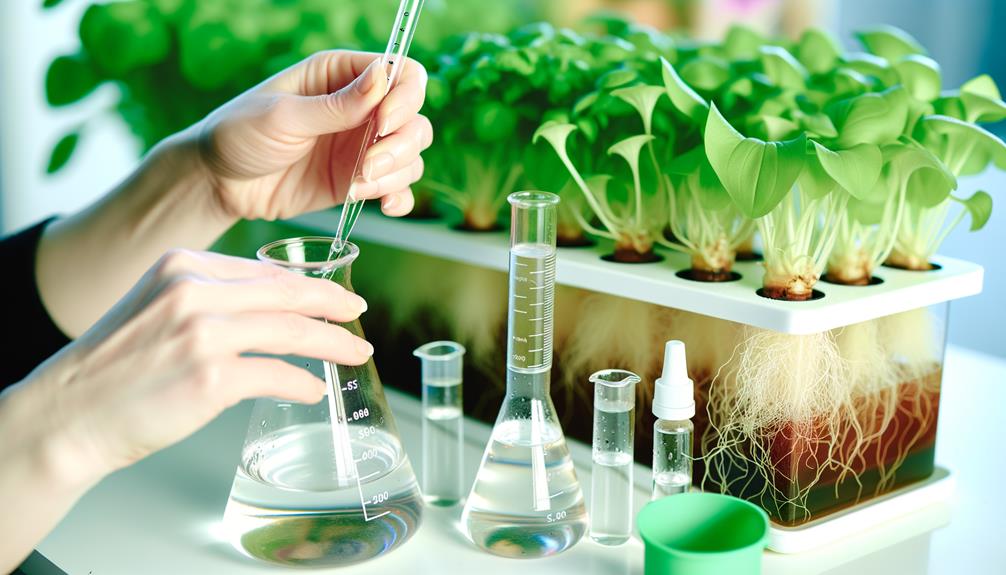
The preparation of nutrient solutions is a critical component of hydroponic systems, involving the precise selection of nutrient formulas tailored to the specific needs of the plants.
Accurate mixing of these nutrient solutions is essential to guarantee ideal nutrient availability and uptake.
Additionally, consistent monitoring and adjustment of pH levels are necessary to maintain the ideal conditions for plant growth and nutrient absorption.
Choosing Nutrient Formulas
When preparing nutrient solutions for a hydroponic system, it is essential to understand the specific nutrient requirements of the plants being cultivated to guarantee ideal growth and health.
Selecting the appropriate nutrient formula is vital; it involves a balanced composition of macronutrients—nitrogen (N), phosphorus (P), and potassium (K)—and essential micronutrients such as iron (Fe), manganese (Mn), and zinc (Zn).
Advanced hydroponic systems may also benefit from custom formulations tailored to the developmental stages of the plants.
Formulas should be optimized for pH stability and electrical conductivity (EC) to ascertain nutrient uptake efficiency.
Innovative growers often leverage data analytics and automation to refine nutrient delivery, maximizing yield while minimizing resource waste.
Mixing Nutrient Solutions
Accurately mixing nutrient solutions requires precise measurements and thorough understanding of the solubility and compatibility of individual components to confirm ideal plant growth.
The process involves the careful dissolution of macro and micronutrients in water, guaranteeing homogeneity and optimal bioavailability.
Key steps to take into account include:
- Measuring: Utilize calibrated instruments to measure nutrients accurately, taking into account the specific requirements of different plant species.
- Sequencing: Dissolve each nutrient individually in water before combining them to prevent precipitation and confirm solubility.
Attention to these details will foster an environment conducive to robust plant development, maximizing the potential of your hydroponic system.
Monitoring Ph Levels
Maintaining ideal pH levels is essential for nutrient uptake and overall plant health in a hydroponic system.
The ideal pH range for most hydroponically grown plants is between 5.5 and 6.5. Deviations from this range can impair nutrient solubility and absorption, leading to deficiencies or toxicities.
Regular monitoring with a calibrated pH meter is vital. Adjustments can be made using pH up (potassium hydroxide) or pH down (phosphoric acid) solutions.
When preparing nutrient solutions, verify all components are fully dissolved before measuring pH.
Consistent pH management not only guarantees ideal nutrient availability but also minimizes stress, fostering robust growth.
Advanced automated pH controllers can further streamline this process, offering precision and convenience for modern hydroponic systems.
Planting in Hydroponics
Selecting the appropriate plants and preparing them for a hydroponic system necessitate a thorough understanding of plant biology and the specific requirements of hydroponic cultivation.
Ideal plant selection hinges on factors such as root structure, growth rate, and nutrient needs. Before planting, seedlings should be germinated in a sterile medium to prevent pathogen introduction.
Key considerations include:
- Root Adaptability: Confirm the chosen plant species have root systems conducive to hydroponic environments, facilitating efficient nutrient uptake.
- Growth Rate: Select plants with compatible growth rates to synchronize nutrient delivery and avoid competition.
Understanding these elements is essential for successful hydroponic planting and subsequent system efficiency.
Maintaining Your System
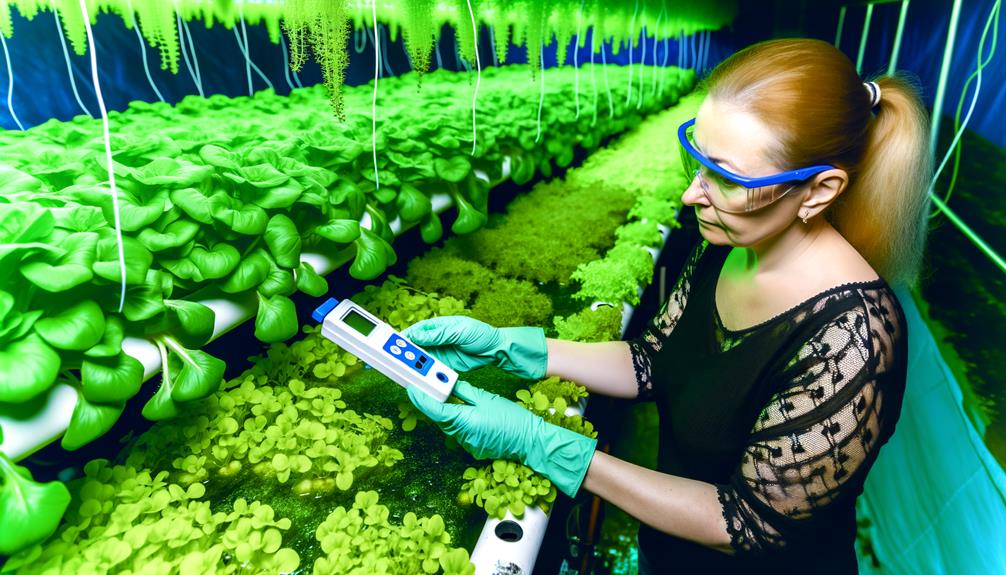
Consistent monitoring and precise adjustments of pH levels, nutrient concentrations, and water quality are critical for the ideal performance and longevity of a hydroponic system. Enhancing these parameters guarantees nutrient uptake efficiency and prevents plant stress. Regularly calibrate pH meters and use calibrated nutrient solutions to maintain balance. Water temperature should be kept between 65-75°F to prevent microbial growth and guarantee dissolved oxygen levels.
| Parameter | Ideal Range |
|---|---|
| pH Level | 5.5 – 6.5 |
| Nutrient Concentration (EC) | 1.2 – 2.0 mS/cm |
| Water Temperature | 65 – 75°F |
Meticulously cleaning reservoirs and checking for clogs in delivery systems can prevent biofilm formation and nutrient lockout, sustaining system efficiency. Implementing these practices will maintain a robust hydroponic environment, fostering plant productivity.
Monitoring Plant Health
Regularly evaluating the physical appearance, growth patterns, and physiological responses of plants is essential for early detection of potential issues in a hydroponic system. Close monitoring guarantees ideal nutrient uptake and environmental conditions.
Key indicators to observe include:
- Leaf coloration: Chlorosis or necrosis can signal nutrient deficiencies or toxicities.
- Root health: Healthy roots should appear white and fibrous; discoloration indicates potential pathogens or oxygen deprivation.
Employing precise instrumentation, such as pH meters and EC (Electrical Conductivity) sensors, assists in maintaining the perfect conditions for plant development.
Regular documentation of observations and measurements fosters a thorough understanding of plant health dynamics, enabling proactive adjustments to the system.
Troubleshooting Common Issues
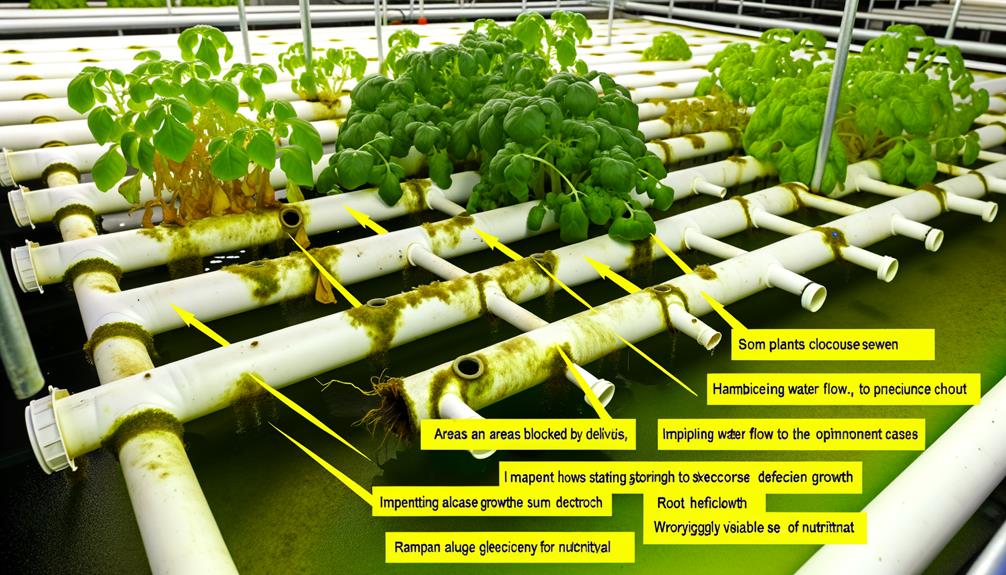
When troubleshooting common issues in hydroponic systems, it is essential to address nutrient solution imbalances and root health complications.
Nutrient solution problems, such as incorrect pH levels or nutrient deficiencies, can greatly hinder plant growth and development.
Additionally, root health issues, including root rot and oxygen deprivation, must be promptly identified and remedied to maintain ideal plant vitality.
Nutrient Solution Problems
Diagnosing nutrient solution problems in a hydroponic system requires a thorough understanding of the specific symptoms and potential causes, including nutrient imbalances, pH fluctuations, and contamination issues.
Nutrient imbalances can manifest as chlorosis or necrosis, indicative of deficiencies or toxicities. pH fluctuations may destabilize nutrient availability, impairing plant uptake efficiency. Contamination, often from pathogens or residues, can hinder plant growth and compromise system integrity.
To troubleshoot effectively:
- Monitor Electrical Conductivity (EC): Guarantees nutrient concentration is within suitable range, preventing deficiencies or toxicities.
- Regular pH Testing: Maintains the pH in the ideal range (typically 5.5-6.5) for nutrient absorption.
Precision in these practices guarantees a robust and productive hydroponic system.
Root Health Issues
Guaranteeing ideal root health in a hydroponic system necessitates vigilant monitoring for signs of root rot, nutrient deficiencies, and oxygen deprivation.
Root rot, typically caused by pathogens such as Pythium, manifests through discoloration and a foul odor. To mitigate this, maintain optimal water temperature (18-22°C) and use beneficial microbes.
Nutrient deficiencies, evident through stunted growth or chlorosis, demand precise pH and Electrical Conductivity (EC) balance in the nutrient solution. Regularly calibrate instruments and adjust formulations accordingly.
Oxygen deprivation, often due to inadequate aeration, results in root browning and reduced nutrient uptake. Employ air stones or oxygenating pumps to guarantee sufficient dissolved oxygen levels.
Proactive measures and consistent system checks are crucial to sustaining root health and maximizing plant yield.
Conclusion
In summary, the meticulous application of hydroponic systems revolutionizes traditional agriculture by enhancing plant growth efficiency, optimizing resource usage, and minimizing environmental impact.
Mastery of various system types, combined with diligent maintenance and vigilant monitoring, guarantees robust plant health and productivity.
Consequently, embracing hydroponics epitomizes the convergence of innovation and sustainability, transforming agricultural practices for a burgeoning global population.
The future of agriculture, illuminated by hydroponics, promises a paradigm shift towards more sustainable and efficient food production methods.


